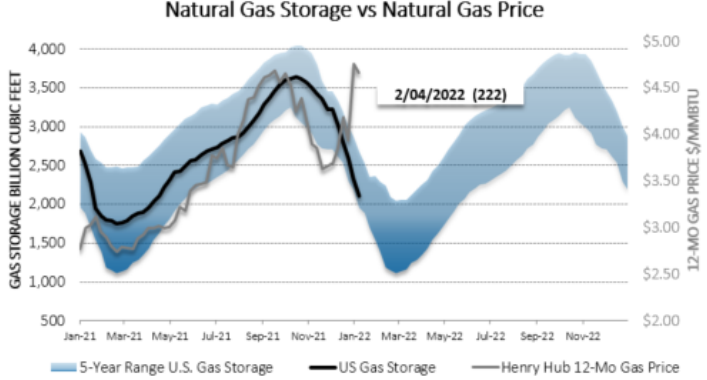POWER MARKETS

WEST The 2022 Pacific Northwest Summer Water Supply Forecast has dipped to 97% of normal, thanks to light precipitation in the Pacific Northwest. Moreover, conditions are expected to be very dry throughout the 1-to-15-day forecast period, so it should sink further. As NYMEX has dropped this week, forward prices for Bal-Year 2022 have followed suit. The lack of extreme temperatures in forecasts for the next two weeks has reduced the fear premium on a national scale.
ERCOT Despite temperatures ranging from the 10s to the low 20s across much of the state a week ago, the real-time market has not behaved accordingly, for 7x24 prices have averaged only $35/MWh over the past week. Last week’s winter peak loads of almost 69,000 MW were very strong yet missed the conservative forecast of approximately 74,000 MW. In addition, because icing did not materialize on a large portion of wind facilities as feared, those assets substantially overachieved with more than 10,000 MW of average production during the cold snap. Amid higher temperatures this week and the proverbial death knell for winter based on current forecasts, forward prices have also taken a breather from their recent run-up. The prompt 12-month strip has dropped by roughly $8/MWh from last week and is currently around $45/MWh. Because prices have held steady further down the curve, this may represent the last buying opportunity for near-term open positions before summer.
EAST As temperatures have managed to avoid the depths of last week, LMPs have started to cool down. While prices in MISO’s Indy Hub have been relatively more stable than in prior weeks, Day Ahead and Real Time prices in PJM’s West Hub have dropped, on average, by $20/MWh and $30/MWh, respectively, since last week. The drops have been even more dramatic over in NYISO and ISO-NE, where the Day Ahead average has plunged by roughly $50/MWh and the Real Time average has nosedived by approximately $70/MWh since last week.